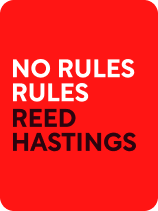

This article is an excerpt from the Shortform book guide to "No Rules Rules" by Reed Hastings. Shortform has the world's best summaries and analyses of books you should be reading.
Like this article? Sign up for a free trial here .
Is it a good idea for company executives to share sensitive information with all employees, including finances and employee profiles? What practices does Netflix use to ensure organizational transparency?
According to Reed Hastings, the CEO of Netflix, there are many benefits of transparency in the workplace. That’s why at Netflix, they are transparent about financial data, job security, mistakes, and even firings.
Let’s look at four specific ways that Netflix practices organizational transparency and the positive outcomes that come from this practice.
Netflix and Organizational Transparency
Once Hastings had created a culture of candor at Netflix, he built on that transparency by making sensitive data—including profit and loss statements (P&Ls) and other financial documents—available to all employees. While direct feedback raised individual performance and increased accountability, Hastings instituted organizational transparency to build employees’ trust in the company and its leaders, which would boost the staff’s sense of ownership and responsibility for contributing to the company’s success. Additionally, he found that one of the major benefits of transparency is that employees are empowered to make the best decisions.
(Shortform note: Bridgewater has a similar principle of extreme transparency, which Ray Dalio describes in Principles: The firm records all meetings and interviews and makes these recordings available to the entire team. Additionally, each employee has a personality profile, which allows co-workers to see everyone’s strengths and weaknesses at a glance. Furthermore, Bridgewater uses an in-house app that allows team members to rate each other in real-time. Such levels of transparency can be uncomfortable, but Dalio emphasizes the importance of putting the team’s best interest before your pride.)
When an executive shares information that’s typically confidential with an entire company of employees, they gain confidence in their standing in the company, loyalty to the company and its leadership, and tremendous trust in the leaders to be transparent. Hastings also takes other measures to create an atmosphere of trust and openness: He doesn’t have an enclosed office, he conducts most of his meetings out in the open, and he even had the locks removed from employee lockers at Netflix’s Singapore office.
(Shortform note: Even though Netflix champions transparency in arguably extreme ways, some argue that more privacy is ideal in a creative environment: One communications agency found that bringing in clients early in the creative process for the sake of transparency can put more pressure on employees and disrupt idea generation. Additionally, too much transparency in any workplace may lead to information overload and, consequently, analysis paralysis, which impedes decision-making.)
By contrast, at most companies, only executives and high-level managers are privy to sensitive information, such as financial data or possible company reorganizations that could lead to job losses. This is because executives don’t think that the information is relevant to lower-level employees or don’t want to upset employees or cause panic.
(Shortform note: Despite Bridegwater’s principle of extreme transparency, Ray Dalio writes that the firm has a few exceptions to the rule. Some information that should remain confidential includes employees’ personal issues that don’t affect the community, sensitive information that can put the long-term interests of Bridgewater or its clients at risk, and information that may be distracting to employees. Such exceptions have led some to opine that Bridgewater only champions transparency when it’s in their own best interest.)
Here’s an outline of Netflix’s transparency practices:
1) Share Financial Data With Staff
For a publicly held company, financial data has an impact on the organization’s stock prices, so sharing this information with staff can be risky. If one of your employees shares your quarterly numbers with anyone outside the company before they’ve been released publicly, that employee could go to jail.
However, Hastings continued to share financial information with his staff even after Netflix went public while also warning them about the serious consequences of leaking it. He even began holding weekly all-staff meetings in which he gave everyone a copy of the P&L and discussed the weekly metrics.
When an employee violated that trust and leaked confidential data to a competitor, Hastings still didn’t back down from his commitment to transparency. He insists that it’s ultimately beneficial to the company—with a deeper understanding of how the company’s doing, employees have a greater sense of ownership as well as the proper context to make decisions without needing information or approval from managers.
(Shortform note: Sharing your financials for context is useless if your employees can’t make sense of raw data. Not everyone who sees the information is an accountant, so make the numbers more easily digestible through simple summaries, graphs, and charts.)
| The Risks of Sharing Financials As Netflix’s experience has shown, sharing financial data (what some companies call “open-book management”) can lead to leaks, whether it’s done deliberately or inadvertently. If you choose to implement this practice, watch out for these other risks that can be just as damaging as leaks: Panic during tough times—when employees see that the company isn’t doing well, they’ll naturally think about the implications for them. Be sure to let them know what you’re doing to get the company back on track, and encourage them to focus on what they can contribute so that they feel like they’re part of the solution. Misalignment—opening books to get everyone aligned can have the opposite effect of creating confusion, particularly in organizations that prioritize other core values over profit. In this case, explain how profit gives the organization the means to fulfill its central purpose. |
2) Tell Employees if Their Jobs Could Be Cut
Even if your company hasn’t come to a decision, Hastings recommends being open with employees about the possibility that their jobs could be eliminated, while emphasizing that you appreciate them and their work and that you want them to stay, if possible. Hastings feels that keeping this secret could make employees feel like strangers in their own companies—and many employees appreciate knowing all the information available to make informed decisions, rather than being kept in the dark and potentially blindsided later.
(Shortform note: Many companies treat possible layoffs as confidential information, so you may not be in a position to alert your staff as Hastings suggests. If an employee asks directly if their job is in danger, experts say that you should reassure them that management is carefully considering all options and that you’ll share more substantive information as soon as possible. If you’ve revealed sensitive information in the past, you’ll be in a tight spot—people will expect you to do it again. Make it a personal policy not to share anything with a select few that you can’t share with the whole team.)
However, this route comes with two risks:
1) The employees could become anxious and distracted, which could interfere with their efficiency at work. (Shortform note: During uncertain times, it’s necessary to show compassion for your employees, but make sure you don’t sacrifice effectiveness. While you should show concern, you shouldn’t tiptoe around giving negative feedback or making decisions that may disappoint employees.)
2) The employees could start looking for new jobs, which means that you risk losing them even if the reorganization doesn’t go through. (Shortform note: If a star employee ends up leaving, stay in touch and consider rehiring them when the time is right.)
Despite these risks, Hastings believes that transparency is the best option because employees will suffer far more stress if they do lose their jobs without notice than they would by simply knowing that it’s a possibility.
(Shortform note: If you’ve been sharing the company’s financials, then the possibility of layoffs shouldn’t come as a complete shock to your employees. To manage stress around layoffs, communicate regularly and clearly with your employees to let them know about the company’s performance and give them a better idea of where they stand.)
3) Be Transparent With Staff About Employees Who Are Fired
When an employee is fired, Hastings advocates for being transparent with the people who benefit from knowing the truth, including the fired employee’s colleagues. When employees know why their coworkers have been fired for work-related actions, they can avoid making the same mistakes. Furthermore, speculation is inevitable anytime someone is fired, so if you get in front of the gossip and share the truth, employees learn that they can trust you to be transparent. Although it’s tempting and common for company leaders to spin or obscure the whole truth, this is a sure way to erode trust among employees.
(Shortform note: Hastings discusses the value of letting employees know when and why someone is fired, but not everyone views the practice as necessary. Some Netflix employees have even described the “postmortem” emails and meetings—which may involve hundreds of people—as “awkward and theatrical.” However, Netflix stands by its policy of organizational transparency, saying that they announce not just bad news, such as firings, but also good news, such as hirings and promotions. )
4) Admit Your Mistakes
Everyone makes mistakes, and Hastings says that owning up to yours encourages employees to take risks despite the possibility of failure. Hastings notes that leaders often fear that being honest about their shortcomings will cause employees to lose faith in them. The pratfall effect states that the opposite is true as long as you’ve already built trust and proven your competence. (Shortform note: The pratfall effect is a phenomenon wherein admitting a mistake can make a competent person seem more relatable and likable.) However, if people already see your performance as inadequate, admitting your mistakes will only worsen their view of your abilities.
(Shortform note: To come across as competent, experts recommend that you learn how to identify and solve problems on your own, pay close attention to explanations so that you don’t keep asking the same questions, and show confidence in your abilities.)
| How to Admit Your Mistakes Hastings says that admitting your mistakes has a number of benefits, but he isn’t explicit about how to go about it. In Thank You for Arguing, Jay Heinrichs outlines a five-step process for owning up to your mistakes while also improving your reputation: Determine your goal. Figure out what you want the outcome to be. Fess up first. Being the first one to talk about your mistake means you can better control the narrative. Use future tense. Immediately follow up your admission with possible solutions and a plan of action. Don’t belittle the victim. Treat the mistake with the appropriate amount of gravity to demonstrate that you care about the consequences of your mistake. Don’t rely on an apology. Apologies reinforce your guilt and may come off as insincere. Instead of saying sorry, acknowledge that you didn’t meet your own high standards. |

———End of Preview———
Like what you just read? Read the rest of the world's best book summary and analysis of Reed Hastings's "No Rules Rules" at Shortform .
Here's what you'll find in our full No Rules Rules summary :
- How Netflix achieved massive success in a short period of time
- The unusual business practices that have helped Netflix sustain its success
- Why Netflix fires adequate employees






